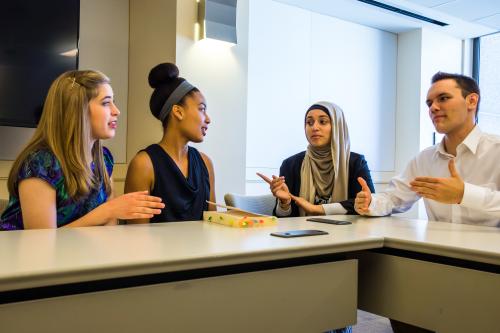The political winds since November have set up 2017 as the year of the white working class. Republicans are beholden to the group for voting them into the Congress and the White House. Democrats are worried they will lose them again unless they retool their message. News organizations, pundits, and scholars of all stripes are frantically trying to understand left-behind voting blocs of older, rural, blue collar whites and those spotlighted in J.D. Vance’s best-selling “Hillbilly Elegy.”
Yet, this near single-minded focus misses a crucial point: America’s white population is rapidly aging. As a result, the nation’s future—both economic and political—is increasingly dependent on young people of color.
When white Americans see that minority children make up ever greater shares of young people in schools and playgrounds, they rarely understand the reason. It is, in large part, because the nation’s white youth are declining in number and have been for more than a decade. Between 2000 and 2015, the United States has seen an absolute loss of 6.8 million white men and women who are younger than age 20, a decline of 14 percent. At the same time, the total U.S. population grew by 14 percent.
The decline of white youth is a national phenomenon, occurring in 47 states and in nearly 90 percent of the nation’s 3100 counties—especially those in the Rust Belt and Appalachia. Census projections reveal that, for decades to come, more young whites will be passing age 20 than will be born or will immigrate. And as the white population ages, there will be proportionately fewer white women of child bearing age.
The main reason we are not facing the declining labor force/extreme aging phenomenon now plaguing Japan, Italy, and other “older” countries is the youthful infusion of workers provided by racial minorities, especially the fast growing populations of Hispanic and Asian Americans. The 2020 Census will show that more than half of Americans under age 18 are racial minorities. Going forward these groups along with African Americans will provide all of the nation’s child population gains as well as all future gains in its labor force.
For this reason, significant investments in the next multiracial generations need to be made. This is not only to assist their own well-being, but also to create a future labor force whose members can contribute to the nation’s economic well-being, and whose taxes will contribute to Social Security and Medicare relied upon by aging white baby boomers.
Getting older whites to understand this demographic reality will be a tall order especially if the Trump administration continues to play to the fears of much of its white working-class base, which does not see today’s highly diverse younger generation as “their” children and grandchildren. Whites who grew up in a less diverse America are uncomfortable and sometimes hostile to demographic change. A 2015 PRRI survey shows that older working class whites think that, compared with the 1950s, America’s culture and way of life have changed for the worse and that immigrants today are a burden. Younger whites and racial minorities believe the opposite.
Yet if today’s multicultural youth are to contribute to a growing economy, there is much work to do. Too many minority children attend under-resourced, segregated schools and do not have the guidance or finances to attend two and four year colleges that are pathways to middle class jobs. Four year college enrollment for Hispanics and blacks, while rising, stands well below that of whites. Income inequality has hit minority youth particularly hard, as seen in continued high child poverty levels; and can only exacerbate the nation’s inequality in the future. Trends such as these make it clear that major public interventions are necessary to improve the well-being of the next generation.
Rather than inflaming this generational divide for political gains, leaders at all levels of government need to emphasize how investments in today’s young minorities and their families—their education, job training, medical care, and housing—will ensure the nation’s future economic and demographic sustainability.
To accomplish this, the Trump administration needs to take a broader view of America’s future than Trump did during the campaign. From a business perspective, he can make the case to the Republican controlled Congress and to the nation that the investment in our largely minority next generation would bring a substantial return in our economic growth, as the white population ages.
To older and middle-aged whites, the “message” that leaders of both parties need to emphasize is their generational co-dependency with younger minorities. While the younger generation would benefit from greater investments in their well-being today, the aging generation will receive support in the form of contributions to Social Security and Medicare as that generation enters the labor force and pays taxes. Perhaps even more important, taking this stand would go a long way toward healing the sharp racial and generational divide that the nation now faces.
The Brookings Institution is committed to quality, independence, and impact.
We are supported by a diverse array of funders. In line with our values and policies, each Brookings publication represents the sole views of its author(s).






Commentary
Op-edIt’s America’s minority youth that deserve both parties’ attention
January 5, 2017